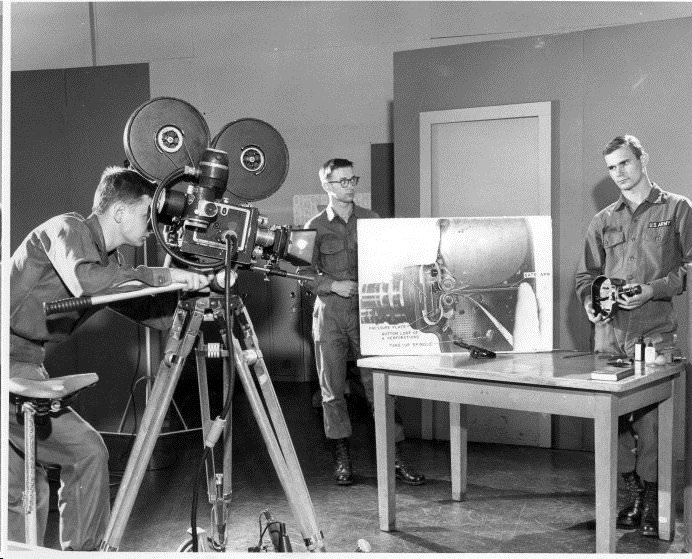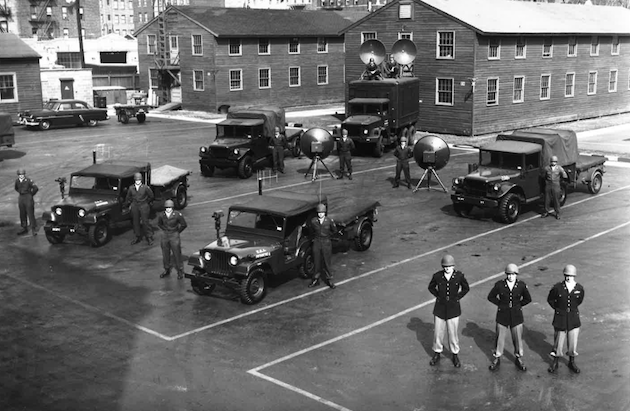The New York Film Studio That Helped the Allies Win World War II – Part II
We continue our discussion with Hal Rosenbluth, President/CEO of Kaufman Astoria Studios, about the studio’s contribution to the war effort. Once the home of Paramount Pictures, the Astoria Studio was taken over by the U.S. Signal Corps at the beginning of WWII in 1943. Then known as the Army Pictorial Center, it was used for the filming and development of Army training and indoctrination films, including Frank Capra's epic Why We Fight series. The basement sound stages were also used for wartime blood drives. The Signal Corps continued to use the facility through the Korean War and even during the ‘anti-communist’ era.
In 1970 the Studio was declared “surplus” and handed over to federal government. When you watch your favorite shows, remember the proud legacy of the stages upon which they were filmed and their contribution to WWII. Below please find our slightly edited conversation with Hal Rosenbluth.
The Army made over 2,000 films during their time at the studio. That is an incredible volume. Have you heard any stories about the environment at the time?
During the Army days they were producing more content than any place in the world because there was a war going on. Look at the list of people [who worked here] – we did a project here, The Glass Menagerie, and Jack Lemon came back; Jack realized this is where he got his start during the Army days. There are many more actors and directors who can say that.
If you look at it in another way, we know because we used to have alumni lunches here – when we first got here and would hear all these stories. They would tell us how they met their wives here, and they got married on the stage and all this kind of stuff, but what was happening was that all these guys who were soldiers that got assigned here were trained to be animators, editors, and cinematographers.
What is your favorite story?
The best story I ever got was from some guys at an alumni lunch. They said they were told by the sergeant, “The captain wants to see you.” Already they got scared and they went to go see the captain and he said, “You are volunteered.” Their first thought was, 'We're dead; we're going to the front line.' What were they volunteered for? Well, they were volunteered for duty back here [Signal Corps Photographic Center] because they lived in subway distance of here. There were only the three little wood barracks; the guys operated similar to a medical resident. They would be on for three or four days and get back in their skivvy clothes go home, and they would rotate people in and out of here that way during WWII. Those guys were known at the “Subway Commandos.” The point is all these folks got trained in this industry. So when the war ended – Where do you go? They went and populated LA.
Were the actors and filmmakers inducted into the Army or were they civilians?
Some were inducted, but most were not. They were still in the industry and hired to do it. The colonel that was in charge during the war years was Frank Capra, the director. So he was making decision on what will actually be made out of [his office in] Washington. The training films were coordinated out of here. They would sneak in General Maxwell Taylor and film him as if he was talking to the troops and it was the film that went overseas, not General Taylor. Not only that, but you also had the propaganda films – Ruby Dee and Ossie Davis kissing goodbye at the train station – all those kind of propaganda films were made here as well.
I think the main exhibit was taken down just recently, but at the Museum of the Moving Image (across from the Kaufman Astoria Studios) they put up an exhibit that was titled “Lights, Camera, Astoria” that was a 20-minute walk through showing the whole history of this area. It has becomes a permanent exhibit, in a smaller scale, to let people know where they are.
How many people do you think were working here at the height of the Army time?
I can only bet that they had a couple thousand. I say that because to run a plant like this just takes a lot of people. Today, when we are filled up and the productions are operating, we know just from security badges we issue, we are sitting between 1500 plus people who are in the building at any given time. So, when I look back at the Army, those numbers probably grew, especially over time. It was not only making films; this was a base. I have met people who have said I worked in the dental office; I was the civilian that was hired to work in the dental office here in the building where the medics’ office was. It was a base, so it meant they needed everything here.


How many shoots could be done simultaneously during the war years?
We added two stages; they could have done six at a time around the building and probably more in the silent days. In the silent days they could do multiple on one stage because they didn’t care about sound! I could have one part of the stage be one production and one part be the other production. Downstairs, on the lower level, they built stages and recording facilities, open areas for both storage and shooting. The Signal Corps Photographic Center (SCPC) had built another stage upstairs. They could do an awful lot. Obviously, just look at the list of projects they did.
How much did you all build and how much of the structure is left over from the Army and even before that?
Some of the stuff is pretty neat and still usable and functional. One of the neatest things that happened is if you go back to 1920 or even 1918 when they were designing the place, what they left behind is the original design our main stage, Stage E, still one of the best stages in world today. Even though they were built with the concept of silent film, they gave me [as President/CEO of Kaufman Astoria Studios] a 40-foot grid height, built the grid out of steal that still to this day is working strong, and when talkies came in, they built up the floor to create some additional soundproofing. So the main facility that is here was built in such a way that it has lasted the test of time. It's probably the most popular stage, certainly in New York.
Did the Army leave anything behind?
When I came, you saw thing like barrels of rations that were here. There was some stuff here equipment-wise; it was shipped out and donated. I know that part only because I attended the University of Florida and in the TV studio I saw their equipment was from here. When I got here we were going to do the construction; I asked about existing building drawings because they were pulled from the building department. We didn’t know what was behind the walls; what the Army would have done during all the years of their ownership of the place. For over a year I was on a wild goose chase – calling the Pentagon – trying to find where these drawings could be. They sent me to Edwards Air Force Base, they told me to call Fort Dix – and you know; they were not to be found. On the humorous side, I think I know where they are. Have you ever seen the movie Indiana Jones?
Sure, yeah.
At the end of Indiana Jones they put the Arc in that giant warehouse – that’s where the drawings must be. I never found them. So, when we were renovating the place we would open up a wall and go, 'Oh, look at this.' It is kind of neat, like in our music recording studio there are isolation booths. They were built by the Army in only a fashion the army could, where you dug separate footings for it and put up shielding so you couldn’t get any RF (radio frequency) bugging because everything was top secret.
What sort of impact did the Army leaving have on the local community?
There is an economic ripple effect on the jobs on the surrounding shops. In this neighborhood the Army brought thousands of people. They had thousands of people employed and working. They would go into the neighborhood and buy newspapers and coffee. They would buy lunch and whatever else they needed to buy. So there was this ripple effect in the neighborhood – plus all the jobs that hired locally to take care of the facility. In 1970 they left – all that stopped –boom. They [the Army] controlled a several block radius. There was this disconnect that happened during the ‘70s. Our job was reconnection. We have people that work for us that tell us that as kids they were not allowed to come south of Broadway.
Why?
The reason they were not allowed to come south of Broadway was because from a child’s point of view, how much fun is it to play in an abandoned building. From a parent’s point of view, nothing good happened in those buildings. You had this disconnect from what was going on in the area; it sat vandalized until ’77. In a seven- year period it went from this thriving campus to nothing.
You have to think of the history, and what took place in those spaces. There are some pretty amazing and historic films that were shot on the campus of the now Kaufman Astoria Studios.
The list of films – you can look up the stars [who worked here] and the films that were done here. It is rather incredible. The modern era will match up to history. We say that we try to get history to be proud of us. We really do believe that, at least I do. We do things like Sesame Street. The projects we have done, just all of the movies that have been shot here [including last year’s Oscar-winning Best Picture, Birdman] hold true with the sort of star power that existed back in the day.
The history of this place is really fabulous and I am really honored and proud to be a part of it. I mean that from the bottom of my heart.




